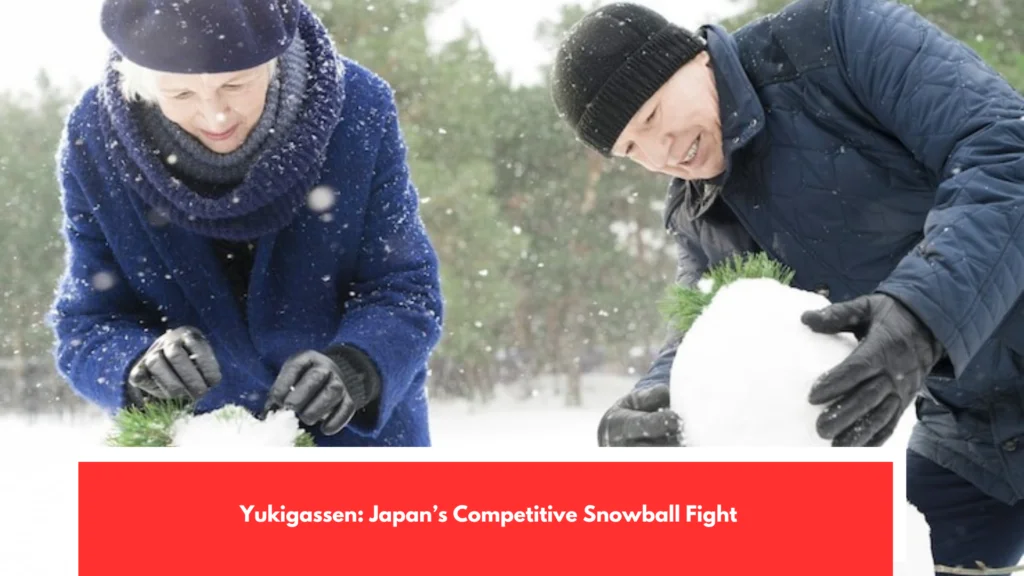Groups of girls and boys have occasionally been hurling snowballs at one another. What a novelty! You can shout. However… What if I told you that they are preparing to compete in a World Championship in Japan? If you think Canadians are weird—and there are a lot of strange people the Japanese are even stranger. One of the things that demonstrates how insane they can be is Yukigassen, the professional art of creating wars with, well, snowballs. Given that the sport was named after the Japanese words yuki (snow) and kassen (battle), its origin is fairly clear. Yukigassen: Japan’s Competitive Snowball Fight” was officially regulated as a sport at the end of the 1980s on the island of Hokkaido, and the first tournament took place there in 1989.
Yukigassen has its own World Cup, complete with a poster, of course. Image: International Yukigassen. Japan has dominated the Yukigassen arena in almost three decades of play, despite the fact that other snow-loving nations like Finland, Norway, Russia, and Thailand also compete internationally. More than 170 teams competed in the 2015 World Cup, but the Japanese managed to retain their title. This is probably because the Japanese national team is stacked with professional baseball players who play during the off-season. Since there isn’t a Yukigassen federation in Spain, we looked to the Canadian team members to learn more about the beginnings of this strange professional hobby.
Yukigassen, a snowball fight game, becomes a popular international sport

Taking a brief respite between workouts. Daily VICE took the picture. Nathan, his brothers Quinten and Anthony, Dr. Tyler Maltman, David Thomson, Reid Maltman, Chris Dziki, Chad Reynolds, and Landon Johnson make up the Canadian crew. Sometimes the difficulties seem to go on forever. As he takes a break to prepare the special snowballs needed to play Yukigassen, Nathan tells me, “They are quite dramatic, snowballs are flying all over very fast and you cannot even see what is going on. According to Nathan, you need to make sure that you have enough ammunition, that your team is working effectively, and that the opposing team isn’t stealing your flag.
The three minutes that the battles last seem like an eternity because there are too many things happening at once and without any breaks. It is comparable to a playground that has completely gotten out of control. However, the teams are identified by the helmets, goggles, and unique overalls worn by the competitors. You can never lower your guard even for a second,” Nathan tells me. The snowballs are premium because they are certified to play Yukigassen, but they are not just any snowballs. Daily VICE took the picture.
A Japanese game that literally translates to Snow Battle

What are the Yukigassen rules You see, the rules are similar to those of dodgeball. Each of the two teams has nine players—seven active and two substitutes and they compete on a field that is 40 meters long and 10 meters wide. Three rounds of three minutes each make up the fights. There are three ways to win those rounds. The first and most obvious is to use snowballs to hit every opponent, which results in one elimination. The victory is immediate. The second goal is to finish the round with more players than the competitors, and it lasts for the full three minutes.
Throwing snowballs has never been so much fun. -Daily Vice Daily VICE took the picture. According to Nathan, this hardly ever happens in Japan because their players’ throws are so accurate. However, there are thousands of flag captures when we play in Canada, and the populace is completely disorganized. They are exhausted, they miss their snowballs, and it is easier to run and grab their flags.
The exciting game of snowballs

The injuries are so serious that the Canadian team will actually send a doctor to treat any injuries sustained during play. They are going to have a bloodbath, according to Tyler, who is wearing the jumpsuit as well but has a stethoscope hanging around his neck. Since the team’s formation, he has been there and has seen everything, including lost teeth and broken bones. After a short while, I get up. I’ve seen a few players fall after being struck by their teammates with actual cannonballs, and I think, “Yeah, it’s pretty and looks like sport, but I don’t know that it’s really good for your health.
I’m not sure, but I guess they get hit pretty hard, but I dare say they don’t know how to play well. Its Japanese name, yukigassen, translates to “Snowball fight” in Spanish. In Japan, this winter activity was formally recognized in the early 1980s. The “Seva-Sindzan” mountain ski resort’s owners came up with the competition concept in the hopes that it would draw tourists. This year, we protected ourselves from the snowballs which, even though they weren’t snowy by donning COVID masks. With pupils in the first through sixth grades, we have played the game in a variety of formats.
Conclusion

The team game, strategy, agility, hiding, throwing, and time to accomplish the goals must all be enjoyable. We also had some really fun fights in the courtyard where we had to protect someone important and get them to safety while the other teams tried to hit them with paper balls. Experimenting with the students and discovering that it works and can be sold for generations to come is fantastic. Yukigassen, a Japanese-developed snowball fight game, is now played internationally, with national competitions held annually in Japan, Finland, Norway, Australia, Sweden, and other countries.
Yukigassen is an exciting game that pits two teams of seven players against each other in a snowball battle. The players must use strategy and skill to outsmart their opponents and be the last team standing. The game takes place on a court divided into two halves, with each team occupying one side. The objective is to eliminate all the players of the opposing team by hitting them with snowballs. The team that has at least one player standing is declared the winner.





